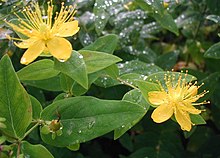
Back عرن ماعزي Arabic عرن ماعزى ARZ Hypericum hircinum CEB Erba bicchina Corsican Stinkende perikon Danish Bocks-Johanniskraut German Aker-belar Basque Hypericum hircinum Italian Hypericum hircinum Portuguese Зверобой козлиный Russian
| Hypericum hircinum | |
|---|---|

| |
| Scientific classification | |
| Kingdom: | Plantae |
| Clade: | Tracheophytes |
| Clade: | Angiosperms |
| Clade: | Eudicots |
| Clade: | Rosids |
| Order: | Malpighiales |
| Family: | Hypericaceae |
| Genus: | Hypericum |
| Section: | Hypericum sect. Androsaemum |
| Species: | H. hircinum
|
| Binomial name | |
| Hypericum hircinum | |
| Synonyms | |
| |
Hypericum hircinum is a species of perennial flowering plant in the St John's wort family, Hypericaceae. It is known as goat St John's wort and stinking tutsan; both names refer to the plant's distinctive odor. The species is a bushy shrub that can grow up to 1.5 meters tall, is many-stemmed, and has golden yellow flowers with conspicuous stamens. The plant has been well-documented in botanical literature, with mentions dating back to at least 1627. Carl Linnaeus described H. hircinum several times, including in his 1753 Species Plantarum which established its binomial. At one point the plant was placed into the defunct genus Androsaemum, but it was returned to Hypericum by Norman Robson in 1985.
Hypericum hircinum is continuously distributed across the Mediterranean and parts of the Middle East. It has also been cultivated throughout Europe, and has become naturalized in several places where it escaped captivity. The species is highly variable in appearance, but its lack of geographic separation means that five subspecies have been established to account for its diversity. H. hircinum has been hybridized with the closely related H. androsaemum to produce the fertile nothospecies H. × inodorum, which lacks the goat-like smell of H. hircinum.
While Hypericum hircinum lacks the high concentrations of several phytochemicals found in other members of its genus, it still has a highly active and useful chemical profile. Extracts from the species contain the highest levels of chemicals when taken from the flowering structures during the fruiting period of the plant. They have been used in folk medicine to treat respiratory diseases by ingestion, and it is also applied topically to treat burns and muscle ailments. Modern evaluations have demonstrated the plant's effectiveness as an antioxidant, anti-collagenase (for cosmetic care), and antimicrobial agent.
© MMXXIII Rich X Search. We shall prevail. All rights reserved. Rich X Search